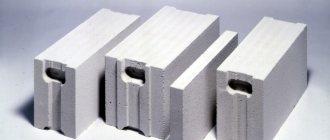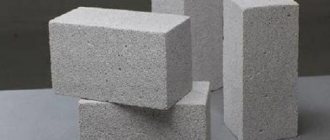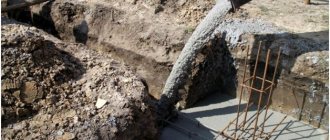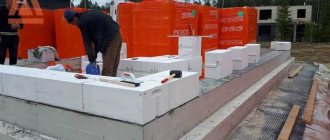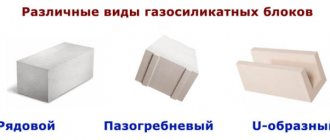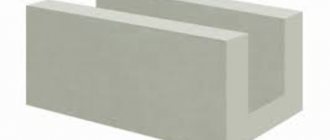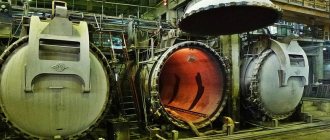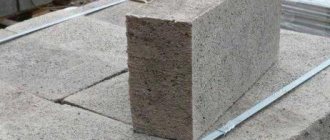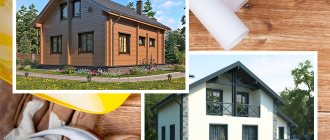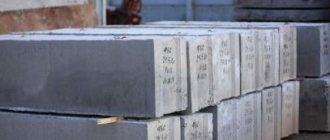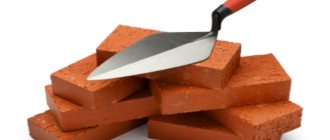What is aerated concrete
Aerated concrete or ceramic block - this choice is relevant for those who want to build a country house. Both materials are considered an excellent choice for low-rise construction, but they have different production technologies and different raw materials.
Aerated concrete is not a very new invention; this technology was first tested in Sweden more than 80 years ago. All this time it was improved, and in the end it was possible to obtain a building material whose characteristics are not much inferior to ceramics, although it does not look as respectable.
Be that as it may, when choosing, many are guided by the price, and in the first case it is much lower. Aerated concrete is made from cement and lime mixed with water and sand. In addition, this composition also includes aluminum powder. It is needed so that when it reacts with potassium hydroxide, small pores are formed (due to the release of hydrogen).
Aerated concrete is produced in an autoclave. The technology is quite simple. The mixture described above is vibrated and then cut into blocks with precise geometric dimensions. It is then steamed in an autoclave at high temperature and pressure to increase the strength of the material without changing its density. The result is a strong and durable material that can be easily processed, including with hand tools. Moreover, no special skills are needed for this.
Aerated concrete is often confused with foam concrete. They are indeed made from similar raw materials. But the technology used is different. And foam concrete has lower performance characteristics. Aerated concrete blocks are distinguished by a very light, almost white tint and smooth surface. Its pores are small. The density of the material can vary in the range of 200-650 kg/m³. But the denser the material, the greater its weight, and at the same time this reduces its strength.
Aerated concrete block. Production methods and performance qualities
To understand the advantages and disadvantages of aerated concrete, you need to find out what it is.
For its production, astringent and siliceous components, water and aluminum powder are used. The following are used as binding components:
- lime;
- cement;
- ash;
- slags;
- a mixture of the above binders.
The silica filler chosen is quartz sand, ash and other industrial waste suitable for recycling. A simplified manufacturing process looks like this: binders and siliceous components are mixed with water to a certain consistency, aluminum powder is added and the mixture is poured into molds.
Aluminum powder reacts with the binder component, releasing hydrogen. During the process of gas formation, hydrogen bubbles fill the material in huge quantities, from which it acquires excellent performance properties: lightness, low thermal conductivity and environmental friendliness.
Ceramic blocks
The ceramic block is a hollow multi-slit artificial stone with grooved side edges. It is made, like brick, on the basis of clay, but at the same time, such blocks are several times larger in size than brick. In addition, they have a microporous structure, which determines their energy efficiency.
Comparing both of these materials, we can say that ceramic blocks have the strength of brick, but at the same time their thermal insulation properties exceed those of aerated concrete. In addition to being an environmentally friendly material, they are also versatile. There are different brands of ceramic blocks on the market, for example M-100, M-125, etc. In terms of frost resistance, these blocks are even superior to brick. They differ not only in strength characteristics, but also in frost resistance. Some types of products can withstand up to 50 freezing and thawing cycles, which is an excellent result for residential construction. After all, even the best ceramic brick can withstand only 35 such cycles.
This material also has a microporous structure, but it is made from clay. It is mixed with sawdust, which burns during firing - this leads to the formation of pores. Why are these pores important? They are filled with air, which reduces the thermal conductivity of the material, and therefore increases its thermal insulation properties. A house built from ceramic blocks will always be warm in winter, and pleasantly cool in summer.
Returning to the production technology of this material, it is worth noting that firing is carried out at a very high temperature - over 1000°C. These blocks have one more common property with aerated concrete - precise geometric proportions. But they are produced differently: their shape and volume are determined by a special extruder of complex configuration. The internal structure of such blocks ultimately represents a slotted structure in which the voids are filled up to 50% of the volume, and this also increases their thermal insulation properties, because the voids are filled with air.
The fire resistance indicators of ceramic blocks are quite good, although in this regard they are still somewhat inferior to aerated concrete. But they provide a better microclimate in the house, since they help the walls to “breathe” naturally, which means they will not develop fungus and mold.
Key Features
Comparing all the properties and parameters of these blocks, we can confidently give first place to ceramics , as a more environmentally friendly and durable material. Both external and internal load-bearing walls are built from ceramic products, and are also suitable for interior partitions.
External differences are not very noticeable . Warm ceramics is a hollow brick, enlarged several times. Aerated concrete block is a porous material. It is made from concrete with the addition of a gas-forming agent. The products have excellent fire resistance. They can withstand temperatures of 1200 degrees for several hours without deforming and retain all their properties. They are very convenient for making fire partitions in buildings.
Ceramic blocks on the sides have a tongue-and-groove structure, so during construction the mortar is significantly saved; it is laid only on a horizontal surface; the sides engage without adhesive. Houses made of ceramic or aerated concrete blocks are much lighter than the same brick or concrete structure, so the load on the foundation is significantly reduced. This allows you to build a lighter foundation.
It is difficult to say which of these materials is better or worse; each has its own advantages and disadvantages. It is advantageous to build low-rise buildings from aerated concrete, while ceramics are stronger and have proven themselves over many centuries to be durable and very strong.
Main performance characteristics
Houses made from aerated concrete blocks are strong and durable. However, in terms of its characteristics, ceramics are superior to aerated concrete. This material absorbs moisture slightly less - approximately 10% for “warm” ceramics versus 35% for aerated concrete.
Ceramic block houses are great for regions with high rainfall. The strength of ceramic blocks is also much higher, so a building made of such material is stronger and will last longer without visible damage. Both building blocks have good vapor permeability, so the building will have a favorable microclimate at any time of the year.
They are distinguished by their soundproofing properties ; they perfectly retain heat in the house. These properties will affect heating costs during the operation of the building. Houses made from aerated concrete blocks retain heat well, while achieving significant savings on heating costs. These types of porous blocks have a low density; they are usually used to make large-sized products, 2-14 times larger than the size of bricks. When constructing a building, significant cost savings come from masonry mortar (special construction adhesives are used).
Aerated concrete: advantages and disadvantages of the material
In order to choose a material for building walls, it is worth summarizing all the advantages and disadvantages of aerated concrete and ceramic blocks in one table. For example, you can draw a sheet into two columns and two columns. One column will be reserved for aerated concrete, the other for ceramic blocks. Accordingly, advantages and disadvantages will be entered in two columns.
So, considering gas blocks, we can highlight the following advantages:
- relatively light weight;
- high accuracy of the geometry of each block;
- acceleration of the construction process;
- excellent thermal insulation characteristics;
- reduction in the labor intensity of masonry work, including due to the absence of the need for additional leveling of walls;
- strength and durability.
At the same time, according to experts, aerated concrete also has quite serious disadvantages. These disadvantages include:
- low bending strength;
- lower moisture resistance compared to foam concrete;
- the need for constant protection from weather conditions during long-term storage;
- risk of cracking.
Ceramic blocks VS aerated concrete blocks/cellular concrete
Masonry made from large-format ceramic blocks does not require reinforcement and the construction of monolithic reinforced concrete belts for installation of floors, and this takes at least 30 days. Finishing work can begin almost immediately after the walls are erected and the roof is installed, since they do not require long-term drying of the walls of the house. High thermal insulation properties make it possible to do without additional wall insulation.
Another interesting fact. Ceramic blocks are stronger than aerated concrete blocks of equal size. Per unit area, ceramics can withstand greater pressure than aerated concrete. The minimum strength here is 10 MPa (strength grade M100). In aerated concrete, most often the strength is 4.8 MPa (strength class B3.5), in rare cases - 6.8 MPa (strength class B 5.0). From a large-format ceramic block, you can erect buildings up to 10 floors with load-bearing walls without additional reinforcing belts and rest the floors and roof directly on the masonry.
And further. Aerated concrete blocks have a large number of spherical closed pores. Thanks to this, aerated concrete blocks take a very long time to dry. During production, the humidity of the blocks is 35-40%, as stated by the manufacturers themselves. Thus, in real construction conditions, aerated concrete blocks still need to be dried to a moisture content of 5% for three years.
The structure of ceramic blocks contains open pores, due to which moisture quickly leaves the block and the humidity of the ceramic is 5% after 150 days. Ceramics also have a unique ability to regulate indoor humidity within a certain range, which creates a microclimate that is comfortable for humans. Excess moisture is absorbed, and in case of dryness, the material releases moisture back, allowing you to maintain a humidity of 30-50% in the house at a temperature of 20-25 ° C without special devices.
As another argument “against” ceramics, many cite the fact that a ceramic block is no different from ordinary red brick. They have no differences in production technology: both materials are created from clay, sawdust and water; molded on the same equipment, dried and fired in the same kilns...
We answer. The main differences between ceramic blocks and traditional bricks are: larger format, a large number of voids and low thermal conductivity. Houses made from a ceramic block are warmer and more comfortable than those made from aerated concrete blocks. This is achieved by a special design of voids and a large number of pores in the ceramic shard.
Crushed sawdust is added to the clay mass (charge) from which the blocks are formed, which burn out in the oven and form pores of an open structure. Due to them, the thermal conductivity coefficient of the ceramic shard is reduced, and a large number of voids in the block increases the path of heat passage.
In addition, the ceramic block for walls has a low thermal conductivity coefficient - 0.123 to 0.145 W/m °C. Houses made of other materials, for example, brick, contain a large number of thermal bridges due to the large amount of mortar, which greatly increases the thermal conductivity of the entire structure.
Due to the tongue-and-groove system on the vertical edges, the ceramic blocks in the wall masonry fit tightly to each other, so mortar in the vertical joints is not needed. During the cold season - which in most regions of our country can reach 6-7 months - in a house made of ceramic blocks you can seriously save on heating without worrying about excessive dry air.
Ceramic blocks: advantages and disadvantages
To summarize, it can be noted that ceramic blocks also have their advantages and disadvantages. In many ways, they coincide with those that are characteristic of building bricks, since both of them belong to ceramic masonry materials. Porous ceramic blocks are made from natural clay with the addition of mineral and organic components that are needed to improve their basic properties. This means that the main advantage of this material is its environmental friendliness.
As for pores, they are formed during the firing process when the raw material burns out. Thus, ceramic blocks retain all the advantages of traditional ceramics, but at the same time have improved thermal conductivity.
The advantages of this material include the following:
- Light weight with fairly significant geometric dimensions.
- A wide selection of shaped elements that can be used to create corners, lintels, and other structures of complex shapes.
- High thermal insulation characteristics, which allow the construction of single-layer walls from 44 cm thick blocks. In the future, such structures will not require insulation: such walls have good thermal inertia, that is, they accumulate heat quite quickly, but release it slowly.
- The use of warm blocks allows you to speed up and simplify the construction process.
- The blocks are fastened using a tongue-and-groove system, which minimizes heat loss through masonry joints. In addition, thanks to this technology, you can save on masonry mortar.
A warm porous ceramic block has lower sound insulation characteristics than solid ceramic bricks, but they are still quite high. The disadvantages of this material include the fragility of its internal structure, which leads to an increase in time and money during loading and unloading operations, transportation and storage. The peculiarity of this material also lies in the fact that it can quite actively absorb moisture, which means additional costs for waterproofing when constructing structures from it. In addition, ceramic blocks can absorb moisture during storage, so they cannot be stored outdoors. Finally, ceramic blocks require additional finishing, and this is another difference from aerated concrete.
Comparison of thermal conductivity
Thermal conductivity is measured by W/(m*k), and the higher this indicator, the higher the thermal insulation properties of the wall will be. But here a very interesting point arises. At first glance, it seems that an aerated concrete block with a rating of 2.0-5.26 W/(m*k) significantly outperforms a ceramic block with a rating of 2.12-3.44 W/(m*k). In reality, this is not always the case. The fact is that aerated concrete blocks have a significant drawback - hygroscopicity. When exposed to moisture, they lose their thermal insulation properties.
Comparison of the characteristics of aerated concrete and ceramic blocks
Ceramics or aerated concrete - the choice is actually not easy. Both materials are a cheaper alternative to brick, have numerous advantages, and both will speed up the construction process and simplify the masonry process.
If we compare the strength of these two materials, ceramic blocks are more durable. They can withstand pressures of 10-15 MPa, despite the fact that they have a slot structure. But for aerated concrete, the same figure is only 0.7-5 MPa. This means that ceramic blocks can be used for the construction of multi-story buildings, but aerated concrete can only be used for single-story buildings. However, for the construction of a private house this is not of fundamental importance.
Comparison of thermal conductivity also makes it possible to choose aerated concrete or a ceramic block. The higher the thermal insulation properties, the better. And it may seem that in terms of this indicator, an aerated concrete block is inferior to a ceramic one. But one should not discount one more indicator - hygroscopicity. It negatively affects the thermal insulation properties. Therefore, the choice in this case is not nearly as obvious as it might seem.
Aerated concrete or warm ceramics - both materials have good soundproofing properties. But it is better to give preference to ceramic blocks. They don't just have good sound insulation. If for aerated concrete it is 45 dB, then for a ceramic block of equal thickness it reaches 53 dB. If we combine this with thermal insulation properties, it becomes clear that, other things being equal, this material is the optimal choice, but only for regions with relatively low atmospheric humidity and a dry climate.
When choosing ceramic blocks or aerated concrete, you can be sure of one thing: these two materials have in common the fact that they can significantly simplify and speed up the construction process (compared to brick or natural stone).
Application area
Aerated concrete segments come in a variety of shapes and have a wide size range.
Aerated concrete blocks are used for various purposes, and therefore the shape and weight vary. Some blocks are used for the construction of load-bearing walls and partitions inside the house. U-blocks are used for various supports. For walls, blocks with protrusions and depressions are used, then there is no need to use glue for the ends. Production immediately creates the material depending on its purpose, using different forms for aerated concrete blocks.
Ceramic blocks are used for laying external walls for any conditions and use. They are called hollow. Porous blocks are used for roofing work. Walls made of ceramic material breathe, do not retain moisture, and retain heat. They are used for the construction of not only one-story houses, but also high-rise buildings. It is one of the most popular materials on the construction market.
Ceramics after installation do not require additional insulation, due to their high strength and low thermal conductivity.
How to make a choice?
To summarize, it can be noted that the opinions of experts regarding the choice of a specific material do not coincide. Some believe that it is better to choose aerated concrete as a lighter and cheaper material, others are inclined to the second option, offering ceramic blocks. In fact, you need to choose taking into account the characteristics of a particular site and project (soberly assessing all the advantages and disadvantages described above) and so as to fit within the allotted budget.
In addition, it should be remembered that aerated concrete has one important advantage - its fire-fighting properties. It is very resistant to fire, so in some cases this material is the best choice when it comes to buildings with an increased risk of fire.
Comparison of the cost of walls made of aerated concrete and expanded clay concrete
Despite the fact that aerated concrete manufacturers shout with one voice that a house made from their material will be much cheaper, in fact this is a bit of a controversial issue.
Comparison of the full cost of walls is not limited to comparing the price of this material; it is necessary to conduct a full analysis of all additional costs:
- If for a load-bearing wall made of expanded clay concrete blocks a thickness of 20 cm is sufficient, then for aerated concrete this is not always enough.
- To cover walls with slabs, it is necessary to use high-grade aerated concrete to avoid cracks in the walls in the future.
- Both materials require insulation and external finishing, so it makes no sense to say that aerated concrete has any advantages in this regard.
- In some cases, expanded clay concrete does not need an armored belt over the walls, and in the construction of walls made of aerated concrete, its absence is not allowed.
Selection tips:
- When choosing specifically between expanded clay concrete and aerated concrete, one separate factor cannot be taken into account. Yes - aerated concrete is warmer, but at the same time its strength is much less, and in some cases, it will be much more expensive. It also implies some problems with finishing, both external and internal.
- It is impossible to judge the difference in the cost of materials without calculating the cost of the remaining stages of construction, such as finishing work, reinforcement, the necessary foundation, and so on.
- Many believe that individual building materials are not safe for health, and in some cases, life, and that it is impossible to build a house from such materials. Try asking these people - what building material is 100% environmentally friendly and safe for health? Most likely there will be no clear answer. As for gas and expanded clay concrete specifically, both of these materials, manufactured with strict adherence to technology, are environmentally friendly and safe for health, no matter what anyone says.
In what cases is it better to use which material?
Today there is a pattern according to which the closer the construction of a house is to the city, the more often preference is given to ceramic bricks or aerated concrete blocks. The further you go, the cheaper materials are used.
The most economical option for building a country house is the use of aerated concrete blocks with floors made of wooden beams. But it has a number of significant disadvantages: after some time, the beams sag and do not have a sufficient level of soundproofing. If the floors are made from cast or prefabricated materials, then costs will increase by 50%.
Foreman's advice : when building a house up to 250 m2, aerated concrete blocks will be the ideal material, but if you are planning a house with a larger area, then it is better to use brick.
Recently, standard ceramic bricks have been replaced by large-format blocks, which speed up the construction process three times. In addition, houses made of ceramic blocks have less load on the foundation and less material consumption during construction. Also, these materials have a significantly higher thermal insulation coefficient compared to classic sand-lime brick.
Advantages of ceramic bricks:
- Excellent thermal insulation. Due to the presence of hollow holes, heat is retained in the block. This allows you to significantly save on home heating costs and not spend money on additional insulation;
- The insignificant specific weight of such bricks reduces the cost of transporting the material to the construction site and makes the work of the builders themselves easier. In addition, the lighter the walls, the less you will spend on laying the foundation;
- Larger forms in which ceramic bricks are produced can significantly speed up the construction process;
- It has high noise insulation properties and provides good vapor barrier;
- Since these blocks are large in size and do not have joining seams, working with them in construction is greatly simplified, and the amount of mortar required for laying is reduced;
- Does not require priming before applying plaster, is well compatible with any finishing materials;
- Environmentally friendly material, consisting mainly of sand, clay and other natural materials;
- Does not deform over time, does not rot or mold.
